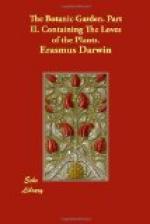THE
LOVES
OF
THE
PLANTS
CANTO IV.
Now
the broad Sun his golden orb unshrouds,
Flames
in the west, and paints the parted clouds;
O’er
heaven’s wide arch refracted lustres flow,
And
bend in air the many-colour’d bow.—
5 —The tuneful Goddess on the glowing
sky
Fix’d
in mute extacy her glistening eye;
And
then her lute to sweeter tones she strung,
And
swell’d with softer chords the Paphian song.
Long
ailes of Oaks return’d the silver sound,
10 And amorous Echoes talk’d along the ground;
Pleas’d
Lichfield listen’d from her sacred bowers,
Bow’d
her tall groves, and shook her stately towers.
“Nymph!
not for thee the radiant day returns,
Nymph!
not for thee the golden solstice burns,
15 Refulgent CEREA!—at the dusky hour
She
seeks with pensive step the mountain-bower,
[Pleas’d Lichfield. I. 11. The scenery described at the beginning of the first part, or economy of vegetation, is taken from a botanic garden about a mile from Lichfield.
Cerea. l. 15. Cactus grandiflorus, or Cereus. Twenty males, one female. This flower is a native of Jamaica and Veracrux. It expands a most exquisitely beautiful corol, and emits a most fragrant odour for a few hours in the night, and then closes to open no more. The flower is nearly a foot in diameter; the inside of the calyx of a splendid yellow, and the numerous petals of a pure white: it begins to open about seven or eight o’clock in the evening, and closes before sun-rise in the morning. Martyn’s Letters, p. 294. The Cistus labdiniferus, and many other flowers, lose their petals after having been a few hours expanded in the day-time; for in these plants the stigma is soon impregnated by the numerous anthers: in many flowers of the Cistus lubdiniferus I observed two or three of the stamens were perpetually bent into contact with the pistil.
The Nyctanthes, called Arabian Jasmine, is another flower, which expands a beautiful corol, and gives out a most delicate perfume during the night, and not in the day, in its native country, whence its name; botanical philosophers have not yet explained this wonderful property; perhaps the plant sleeps during the day as some animals do; and its odoriferous glands only emit their fragrance during the expansion of the petals; that is, during its waking hours: the Geranium triste has the same property of giving up its fragrance only in the night. The flowers of the Cucurbita lagenaria are said to close when the sun shines upon them. In our climate many flowers, as tragopogon, and hibiscus, close their flowers before the hottest part of the day comes on; and the flowers of some species of cucubalus, and Silene, viscous campion, are closed all day; but when the sun leaves them they expand, and emit a very agreeable scent; whence such plants are termed noctiflora.]




